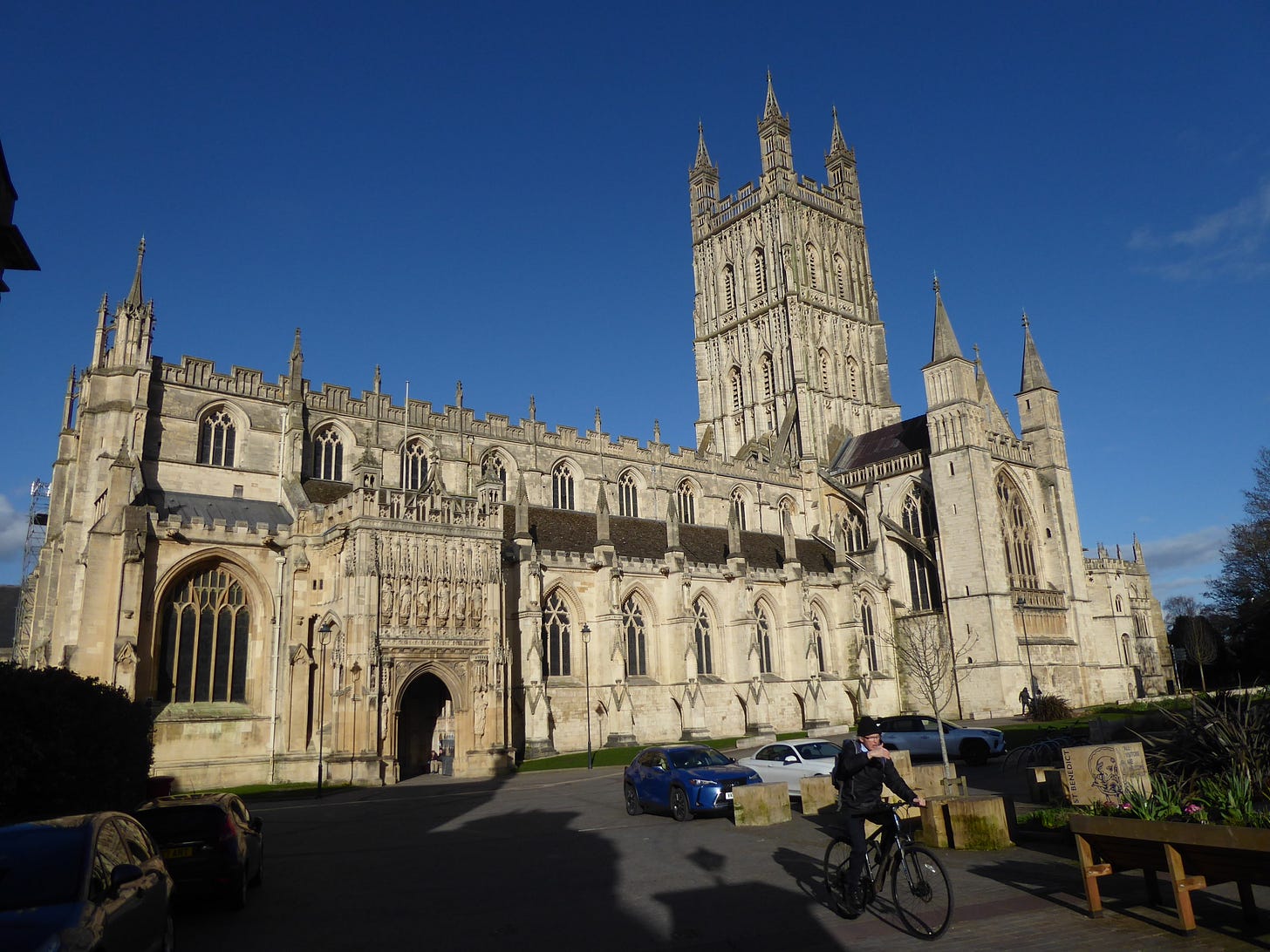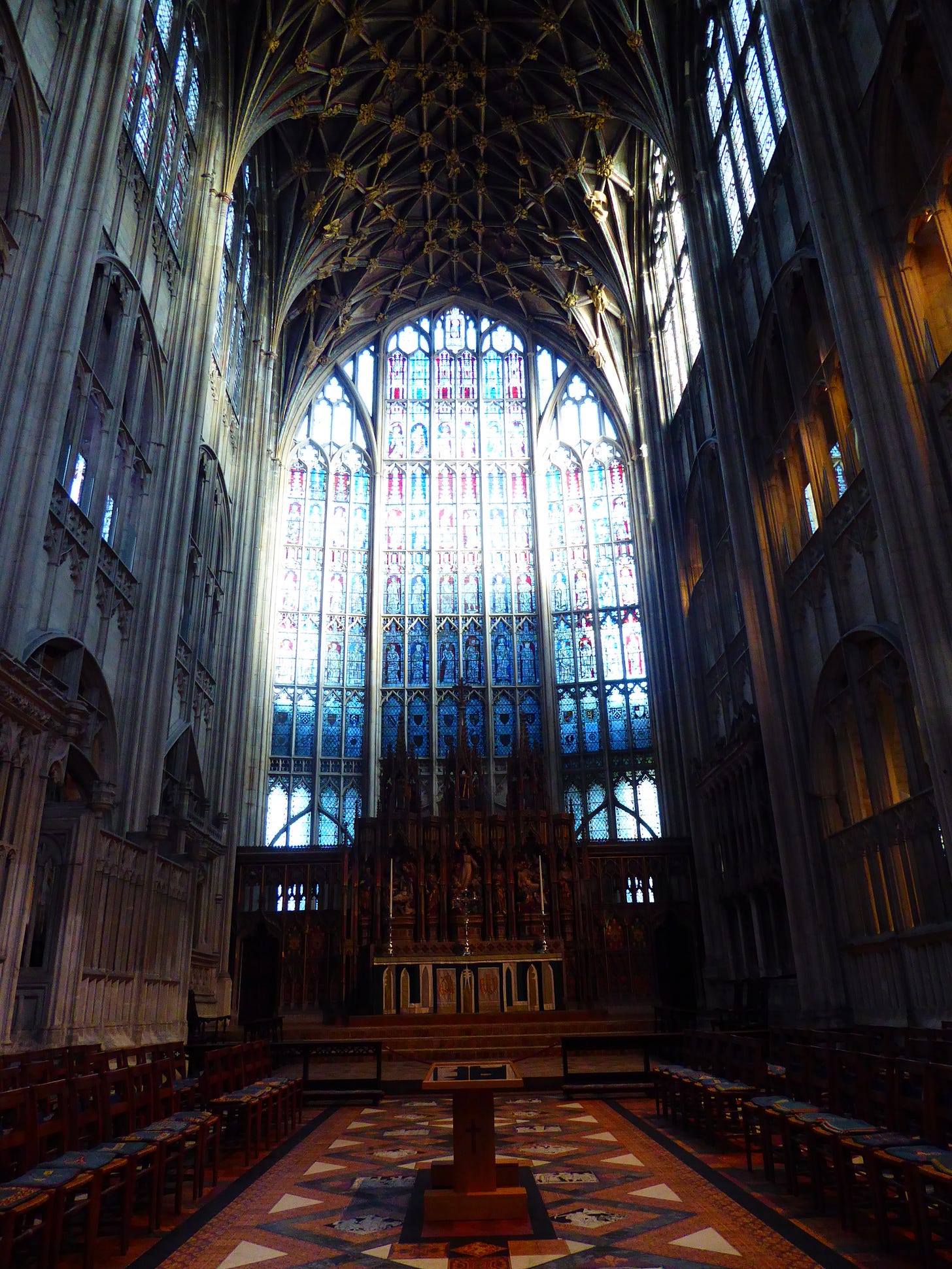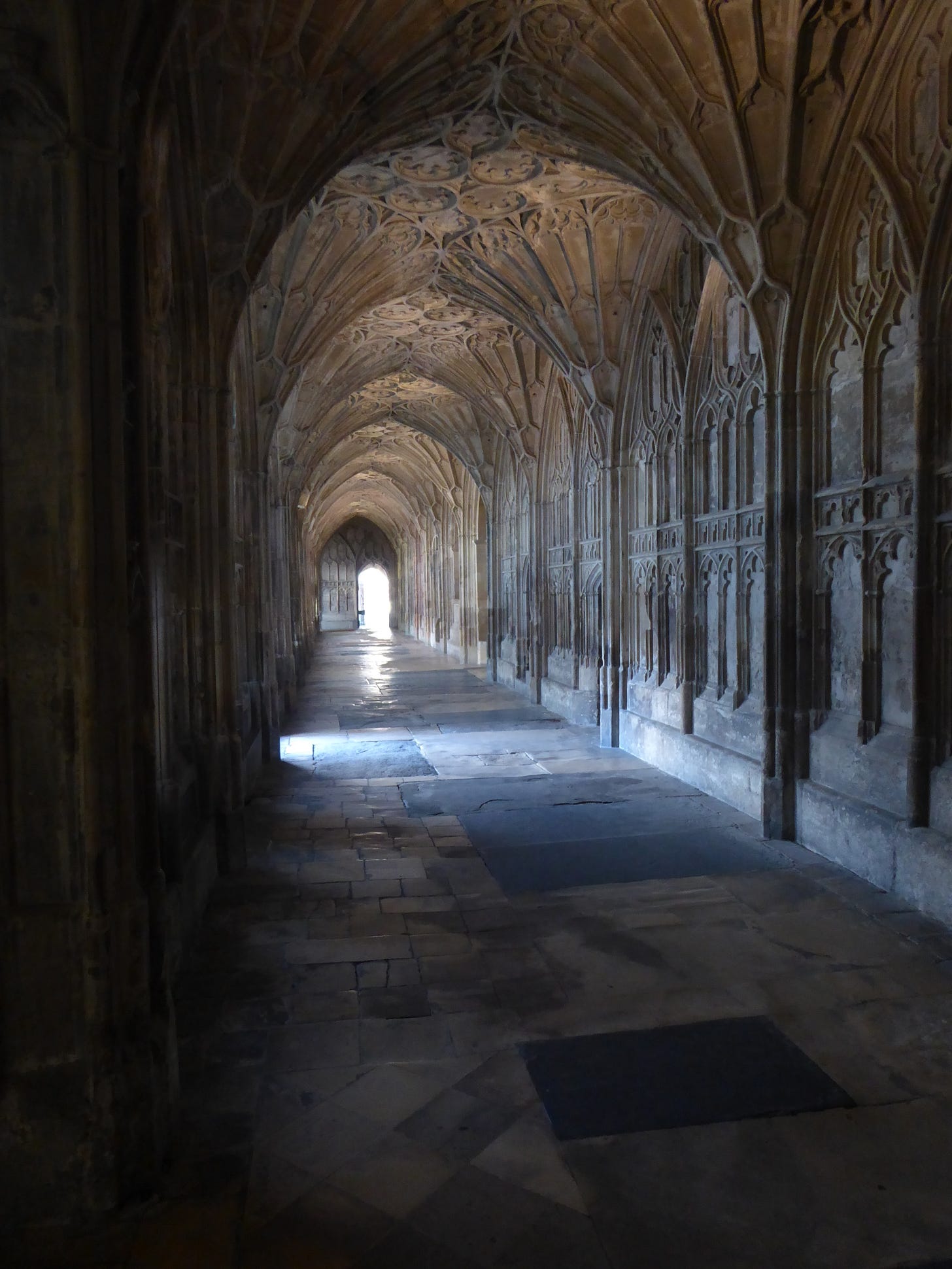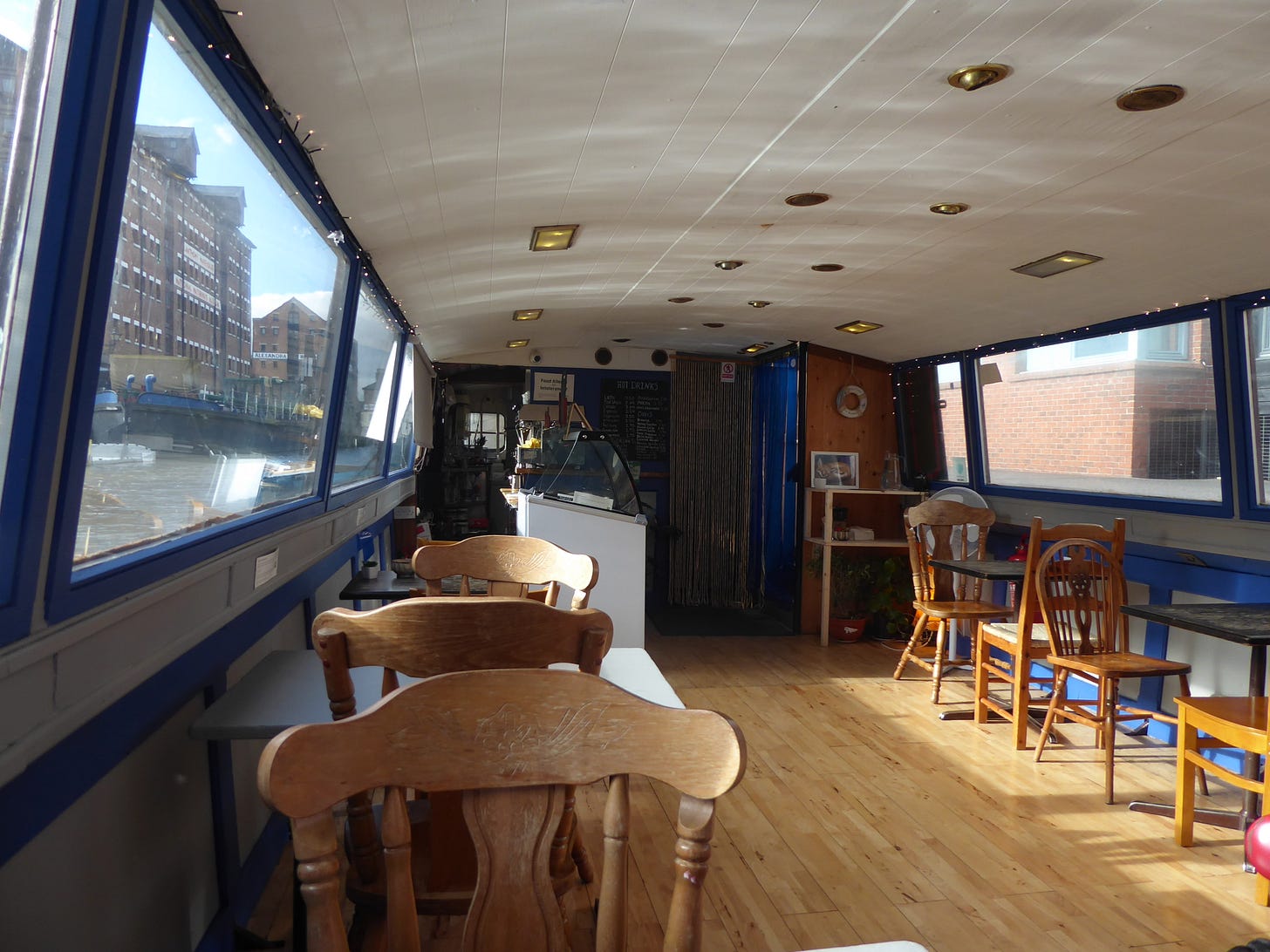Last week my paid subscribers got to read about me gongoozling on the Grand Union Canal as part of my A to Z of the British Isles. However, I have another G to share, so I thought that I would share my trip to Glorious Gloucester with everybody this week.
Doctor Foster went to Gloucester,
In a shower of rain;
He stepped in a puddle,
Right up to his middle,
And never went there again.
Like Dr Foster, I went to Gloucester in a shower of rain but by lunchtime it had brightened up. Okay, it doesn’t scan as well as the famous nursery rhyme but at least it’s accurate.
The rhyme, in case you were wondering, was first published in the form we know in 1844 but is probably much, much older than that. There is another rhyme featuring the eponymous doctor in Gammer Gurton’s Garland, published in the 1780s, where it appears that Foster may not have been a medic, as one might presume, but a Doctor of Divinity as:
Old Doctor Foster went to Gloster,
To preach the word of God,
When he came there he sat in his chair,
And gave all the people a nod.
A rhyme with even less plot than the one where he fell in a puddle but it may allow us to identify the cleric as an emissary of the Archbishop of Canterbury, sent to Gloucester to tell them what William Laud – Archbishop from 1633 to 1645 – thought about the positioning of communion tables.
I know, the story does not really get any more exciting, does it? However, the story goes that whoever our doctor was, he trudged through Gloucestershire telling people that the communion table should be at the east end of the church, rather than in the middle, but he couldn’t make it to the village of Deerhurst as the Severn was in flood. To this day, the Priory Church of St Mary has a communion table in the centre of the chancel rather than an altar at the east end like most other churches.
Before being made Archbishop, William Laud was Dean of Gloucester Cathedral and it was here on a spring afternoon that I headed. It is, as cathedrals are wont to be, breath-taking. The scale of it is immense, huge stone pillars, great vaulted ceilings and stained glass windows so high that only the angels can peer at the saints depicted there face to face.
The great east window behind the altar is twenty-two metres high and twelve metres wide. That’s, essentially, a vertical tennis court made out of coloured medieval glass.
Then there are the cloisters, you know the cloisters at Gloucester Cathedral, even if you don’t think you do. The Spanish Princess, based on the novels of Philippa Gregory; Wolf Hall, based on Hilary Mantel’s books; The Hollow Crown, adapting some of Shakespeare’s plays; and, of course, the Harry Potter movies. All of these have used Gloucester’s cloisters as a backdrop. So, even if you can’t visit, you can visit.
After visiting the cathedral, I walked by the green outside and into a little lane called College Court. This is like a real life Diagon Alley, but stranger. After making your way through a low, stone-gated passageway, you arrive at The World of Beatrix Potter. There doesn’t appear to be much connection between Miss Potter and the city apart from her Christmas story, The Tailor of Gloucester. In this story, Beatrix’s personal favourite, some mice finish off sewing a waistcoat to thank the tailor for rescuing them from a cat. This is actually based on a true story from Gloucester.
In the real world, or as close to it as you can get in College Court, the actual story was that a Gloucester tailor called John Pritchard was commissioned to make a suit for the city’s new mayor around the turn of the nineteenth into the twentieth century. He returned to his shop on Monday morning to find that the suit had been completed over the weekend. Although it was certainly completed by his assistants, he promoted the story that it had been done by the fairies. And who are we to argue with that? Had his shop actually been here in College Court, though, I could almost believe him. John Samuel Prichard's shop was actually at 45 Westgate Street but when Beatrix Potter painted the illustrations for her own book, which was published in 1903, she drew this building here, number nine College Court.
The next shop on the left is called Cauldron Creations and I went inside. It sells crystals, potions, tarots and wands and really is a witchcraft store. I spoke to the lady behind the counter who told me that she was a Hedge Witch. Apparently that’s someone who believes in looking after nature. If you’re going to believe in something, then that’s as good as anything and certainly of more use to the world than believing the fairies made your suit or that it matters an otter’s chuff where you put the communion table.
Mt. Moon tattoo parlour (by appointment only) sits opposite Pilgrim which sells incense and crystals and supports holistic wellbeing according to the sign outside. College Court isn’t like many other places you’ll visit. It opens out onto a wide, pedestrianised shopping street which is really quite nice as city centres go. The shops on the ground floors wouldn’t look out of place just about anywhere but the storeys above clearly have stories to tell. Every kind of building from Elizabethan black and white through Georgian brick and Victorian sandstone to twentieth century concrete.
I wasn’t here to shop, though, I was here to visit the quays. Now Gloucester Quays is the name of a shopping mall but it’s a shopping mall beside what were the docks on the Gloucester and Sharpness Canal. The old warehouses have been converted into shops and restaurants and apartments and a museum or two but they look stunning on a sunny early spring day. I decided to eat not at the waterside cafes and restaurants but actually on the water. There’s a barge which is now a café and allowed me to sit and look out across the water at the red-brick, six-storey old warehouses which now house the National Waterways Museum.
I loved it, honestly, Gloucester is glorious. I won’t take Dr Foster’s lead, I will definitely go there again.










